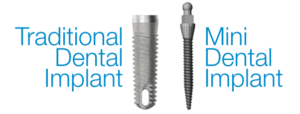Mini Implants—Are You Sure?
Let’s discuss mini dental implants—the option that is getting more and more popular due to (perceived) lower cost of treatment.
Simply stated, mini implants are narrower than traditional implants (2-3 mm in width vs 3 mm or more for traditional implants). As advertised, they can be placed into narrow bone, avoiding the need for bone grafting procedures. However, due to the fact that they are narrower and are placed into narrower, less stable bone, more mini implants (4-6 vs traditional 2 implants) often need to be placed to support the same denture. These mini implants also need to be placed more posteriorly (to the back of the jaw), increasing the risk for damage to the nerve that runs inside the lower jaw.

What is also often not mentioned, however, is that mini dental implants rely on purely mechanical forces to hold on to the bone (much like a traditional metal screw that is screwed into the wall to hang a picture). Traditional dental implant, on the other hand, osseointegrates, or fuses to the bone, providing a stable, long term foundation for the crown or denture support.
So, lets summarize: Mini implants—need to place more of them, into less stable bone, jeopardizing the nerve, providing less stable long term foundation for the denture due to the fact that the mini implants are just “hanging on” to the bone.
Traditional implants: often need only two, placed into stable bone, fuse to the bone to provide stable, long term solution, often at LESS COST than mini implants.
What would you like to have? If you are thinking traditional dental implants, you’ve made the right choice!
− Dr. Dmitry Tsvetov
Call us today ☎ Temecula Facial Oral Surgery Phone Number 951-302-9100 and come in for a FREE dental implant consultation—we will be delighted to discuss this with you in more detail.
Comments are closed.

